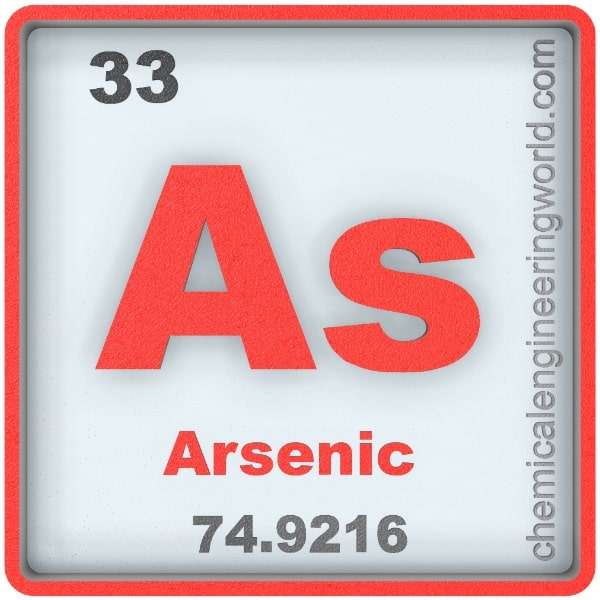Arsenic Element Properties and Information

Arsenic Element Properties and Information
Arsenic is the thirty-third element on the periodic table. Elements are arranged in the periodic table on the basis of the atomic number. Atomic number is the number of protons in the nucleus of the atom. Arsenic has an atomic number of 33. It is located in the Group 15 and Period 4 of the periodic table of elements. It is denoted by As. The name is derived from the Greek word ‘Arsenikon’.
Arsenic has been documented to be known by ancient Egyptian and Chinese civilization and the information about toxicity of arsenic was also known since ages. Albert Magnus is attributed as the discoverer of Arsenic element around the year 1250.
Arsenic is the fifty-third most abundant element which comprises 1.5 ppm of Earth’s crust. It is commonly found in combined state in minerals. It is rarely found in its native state. The most common mineral which contains arsenic is arsenopyrite.
Physical Properties
- Arsenic is a bright silvery-grey metalloid. A metalloid displays properties intermediate between a metal and non-metal.
- The atomic mass of arsenic is 74.92
- The sublimation point of arsenic is 615°C
- The density of arsenic is 5700 in S.I. units at 20°C
- There are three common allotropes of arsenic; gray, black, and yellow. Gray arsenic is the most abundant among them.
- Arsenic has only one stable isotope in nature; arsenic-75.
Chemical Properties
- Arsenic remains stable in dry air but as soon as it is exposed to humid atmosphere, the surface begins to tarnish resulting in formation of a black oxide layer.
- If arsenic is heated in air, it transforms to arsenic trioxide, the odour of the vapour resembles garlic.
- Arsenic directly transforms from solid phase to gas phase when heated in atmosphere to temperatures of 615°C.
Methods of Production
Roasting: Arsenopyrite mineral is roasted in presence of air to yield arsenic trioxide. If it is roasted in absence of air then gray arsenic is obtained. If high degree of purification is required, such as from sulfur and other chalcogens then sublimation is to be done under a vacuum. After arsenic trioxide is obtained, it is mixed with olive oil and then heated to yield the arsenic metal itself.
Relevance in Chemical and Related Industries
- Alloys: Arsenic is alloyed with lead to increase its strength. These lead alloys are primarily used for car batteries.
- Ceramics: Arsenic is used as an opacifier in ceramics to create white glazes.
- Insecticides: Since arsenic is poisonous to insects, the chemicals containing arsenic have been used as wood preservatives and also to ward off insects from agricultural fields. For example, monosodium methyl arsenate and disodium methyl arsenate.
Relevance in Other Industries
- Poultry: Arsenic is used in poultry industry to increase the gain in weight, improve feed efficiency, and prevent diseases. Organic arsenic compounds promote the growth of chickens.
- Medicine: A radionuclide of arsenic, arsenic-74 is used to locate tumors.
Health Effects on Exposure
- Organic Arsenic: These are far less toxic than inorganic arsenic compounds but over exposure may cause stomachache or nerve injury.
- Inorganic Arsenic: Mediocre exposure causes irritation in stomach and intestines, decrease in blood cells, lung irritation. Large exposure causes heart disruption and brain damage.
Effects on Surroundings
- Plants: Plants absorb inorganic arsenic fairly easily. Beings that eat the plant may get exposed to high concentrations of arsenic.
- Fishes: Arsenic concentration is higher on the surface waters wherever industrial pollutants are dumped. Fishes are exposed to this arsenic due to which their genetic material gets altered. If birds eat the fishes then they die due to arsenic poisoning as the fish starts decomposing in the stomach of the bird.
References:
https://www.rsc.org/periodic-table/element/33/arsenic
































